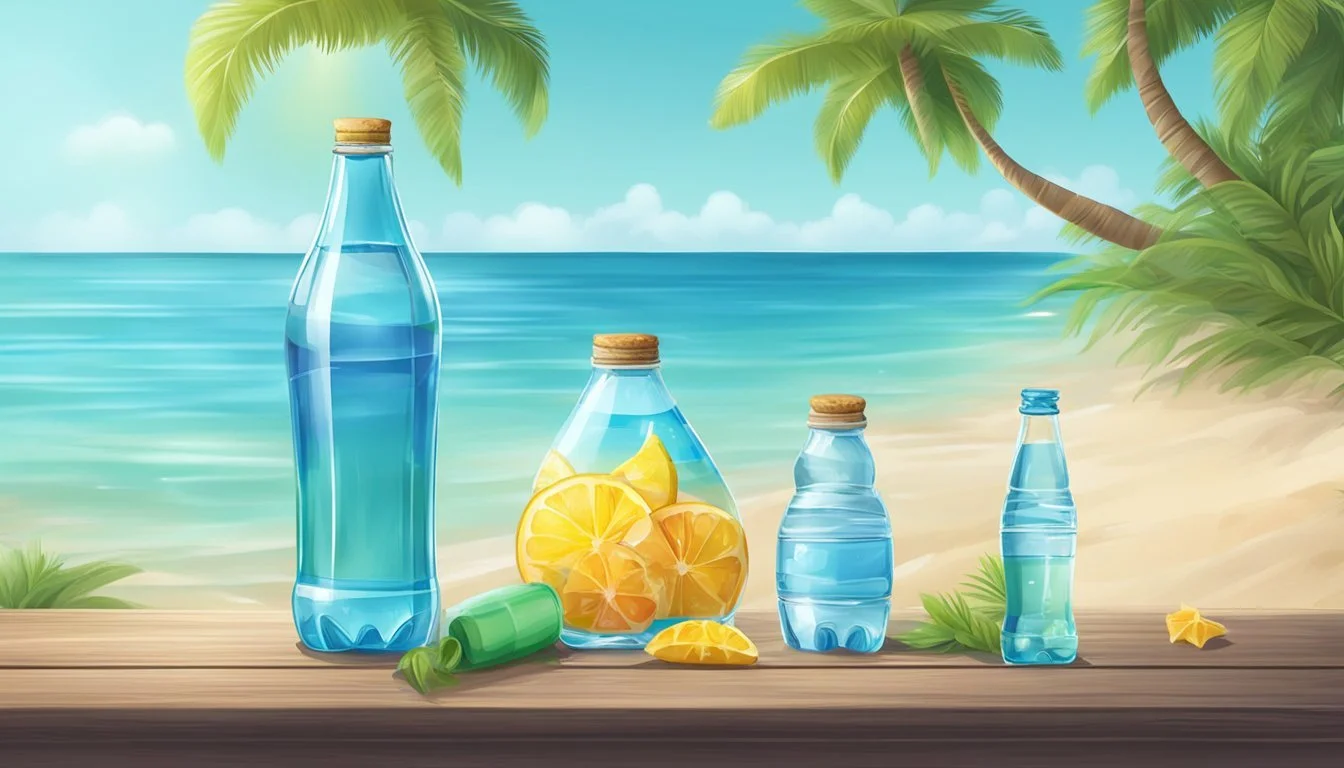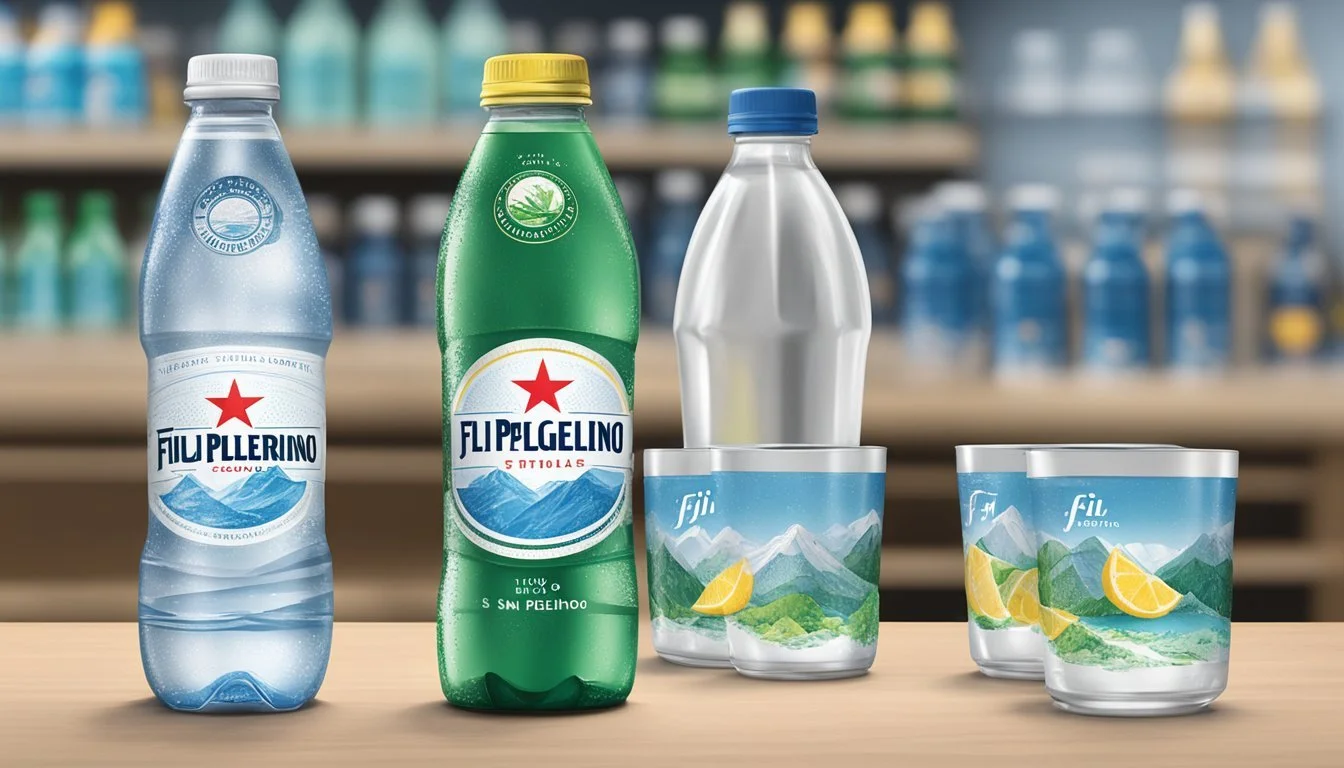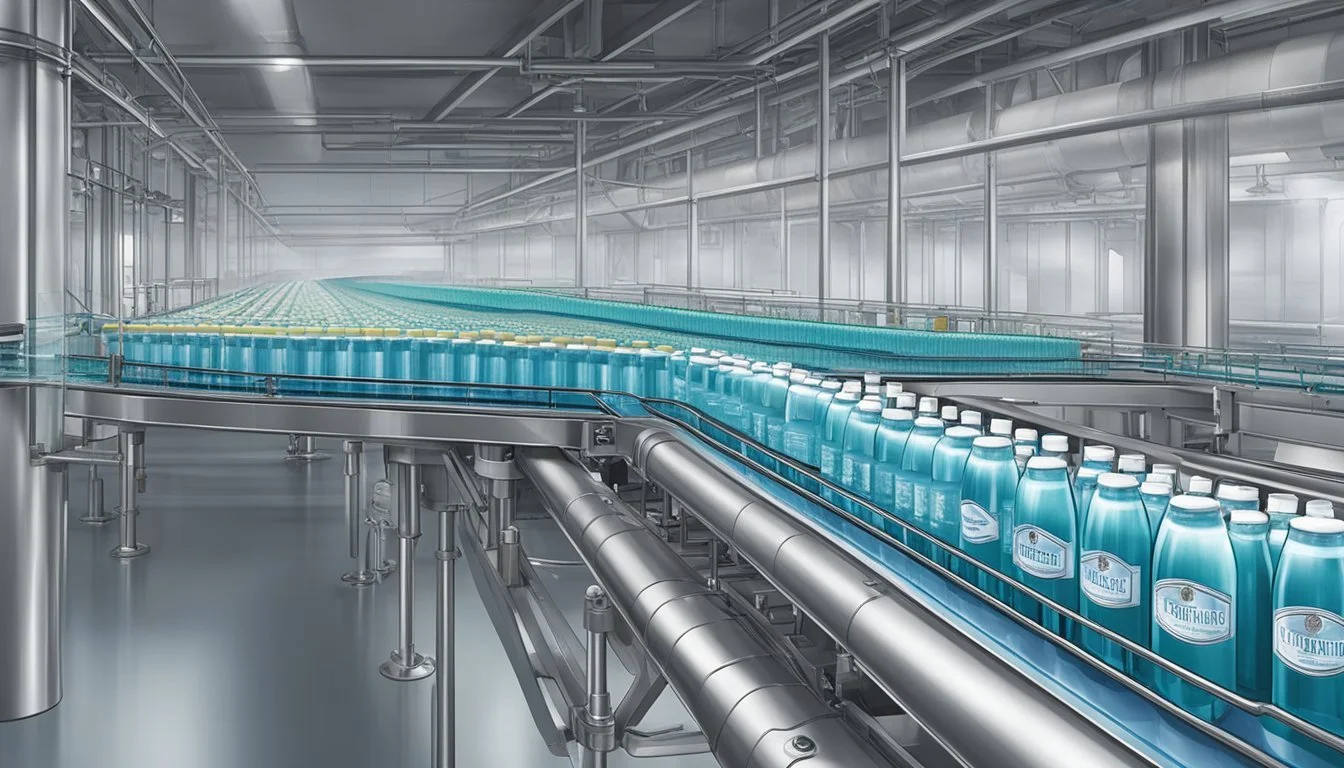Fiji vs. San Pellegrino
A Comparative Analysis of Bottled Water Quality
When it comes to bottled water, two brands often stand out as premium options in a sea of choices: Fiji and San Pellegrino. Both brands have carved out a niche for themselves, offering customers more than just hydration but a taste of luxury and a promise of quality. Fiji Water, sourced from an artesian aquifer in the remote Fiji Islands, boasts a unique mineral profile and a soft, smooth taste. Encased in its signature square bottle, it's not only a beverage but also a status symbol for some, emphasizing purity and a connection to an exotic locale.
On the other hand, San Pellegrino, with its Italian heritage, is synonymous with sparkling mineral water, known for its fine bubbles and subtle nuances of taste. Hailing from the Lombardy region, the brand has long been associated with fine dining, often seen gracing the tables of gourmet restaurants. Its mineral content, contributed by the journey through the Alpine rocks, is credited for enhancing the water's flavor and pairing well with a wide range of cuisines.
Historical Background of Bottled Water Brands
The historical journey of bottled water brands is marked by Fiji Water's rise in the Pacific, and San Pellegrino's century-old roots in the Italian Alps. Each brand's unique heritage has shaped their growth and contribution to the bottled water market.
Fiji Water's Emergence and Growth
Fiji Water began making its mark in 1996 when a Canadian businessman founded the brand. The source of its water is an artesian aquifer located in the remote Yaqara Valley of Viti Levu, Fiji. It quenched the thirst for luxury bottled water and quickly became a prestigious beverage, competing with and eventually outpacing renowned brands like Evian in the American market. Today, it is recognized for its soft taste and iconic square bottle.
San Pellegrino's Italian Heritage
San Pellegrino's history dates back much further, originating in the province of Bergamo, Lombardy, Italy. Since 1899, San Pellegrino has been bottling sparkling mineral water from springs in the Italian Alps. Acquired by Nestlé in 1997, the brand is now synonymous with Italian style and elegance, favored across continents for its fine bubbles and balanced mineral content. It has standing in the world of gastronomy and is often served in restaurants as a companion to fine dining.
Water Sources and Natural Composition
When comparing Fiji Water and San Pellegrino, the distinct characteristics of their sources are crucial. Each brand's water is unique in mineral content and taste because of its specific geological origins.
Understanding Fiji's Artesian Aquifer
Fiji Water originates from a sustainable artesian aquifer located in the remote Yaqara Valley of Viti Levu, one of Fiji's two principal islands. This aquifer is naturally protected from external elements and pollutants by a thick layer of volcanic rock. The water is drawn from an underground source that is replenished by rainwater filtered through mineral-rich volcanic soil. This process enriches Fiji Water with minerals and electrolytes, imparting a soft mouthfeel and a smooth taste.
Mineral Content of Fiji Water:
Silica: Approximately 93mg/L
Calcium: About 18mg/L
Magnesium: Around 15mg/L
The fact that Fiji Water is artesian indicates that it comes from a confined aquifer containing groundwater under positive pressure. This pressure facilitates the water's rise to the surface without the need for mechanical pumping, which is why Fiji Water touts its source's natural purity and beneficial mineral composition.
The Natural Spring of San Pellegrino
San Pellegrino's source is a natural spring located in the Italian Alps, near Bergamo (Lombardy). Protected by a 400-meter thick layer of dolomitic limestone, the water emerges at the surface enriched with minerals, having traveled a vast distance of approximately 30 years from precipitation to bottling. The journey of the water through the mineral-rich layers of rock imparts the distinct mineral water profile San Pellegrino is known for.
Mineral Profile of San Pellegrino Water:
Bicarbonate: Over 200mg/L
Calcium: Approximately 160mg/L
Magnesium: About 50mg/L
Sulfates: Roughly 40mg/L
San Pellegrino is labeled as mineral water because of the significant amount of minerals it contains. These minerals, acquired during its underground journey, are what contribute to its recognizable taste and its reputation as a dining accompaniment, believed to enhance the flavors of food.
Physical and Chemical Properties
In evaluating bottled water, the mineral content and pH levels are crucial indicators of quality. Not only do these factors affect the taste and health benefits of the water, but they also determine its suitability for various dietary needs.
Comparative Analysis of Mineral Content
Fiji and San Pellegrino water distinguish themselves with their unique mineral compositions. Fiji Water originates from an aquifer in the Fiji Islands and is noted for its high silica content, which is associated with its smooth mouthfeel. On the other hand, San Pellegrino, sourced from San Pellegrino Terme in Italy, is renowned for its rich blend of minerals, which include calcium, magnesium, and bicarbonates.
Fiji Water:
Calcium: Low levels, contributing to a softer taste.
Magnesium: Present in moderate amounts, may promote relaxation and muscle function.
Potassium: Detectable, contributes to the overall electrolyte balance.
Chlorides: Minimal, maintaining a clean taste profile.
San Pellegrino:
Calcium: High levels, often exceeding 150 mg/L, beneficial for bone health.
Magnesium: Abundant, typically around 50 mg/L, aiding metabolic processes.
Potassium: Moderate quantities, enhancing the nutrient profile.
Chlorides: Higher concentration, imparting a characteristic taste.
Assessing pH Levels and Alkalinity
pH levels are an essential aspect of bottled water, influencing both its health implications and taste. Alkaline water, which has a pH above 7, is theorized to offer health benefits such as neutralizing acidity in the body. Fiji Water is known to have a pH of approximately 7.4, making it slightly more alkaline than tap water. San Pellegrino, however, often exhibits a higher pH due to its natural carbonation, sometimes reaching a pH of 9.5. This alkalinity is thought to stem from the water's underground journey, where it comes into contact with limestone and volcanic rocks, enriching it with minerals and elevating its pH.
Bottling and Purification Processes
When examining the quality of bottled water, the methods used for purifying and bottling are critical components that affect not only the taste but also the overall health benefits of the water. Fiji and San Pellegrino utilize distinct techniques that cater to their brand's unique profiles.
Fiji's Approach to Water Purification
Fiji Water undergoes a natural filtration process as it is collected from an underground aquifer in the Fiji Islands. This natural journey includes passage through volcanic rock which provides a form of purification along with the addition of minerals. After extraction, Fiji Water goes through further steps to ensure purity and quality. These steps are:
Microfiltration: To remove any remaining impurities, ensuring clarity and safety.
Bottling at the source: Fiji bottles its water directly at the source, which minimizes the potential for contamination and maintains the water's natural composition.
San Pellegrino's Carbonation and Filtration
San Pellegrino, originating from a spring in the Italian Alps, is known for its sparkling mineral water. Its purification and carbonation process consists of:
Natural mineral filtration: As the water flows deep underground, it moves through porous rock formations, which enrich it with minerals and facilitate a pristine filtration process.
Addition of carbon dioxide (CO2): After the water emerges at the surface, carbon dioxide is purposefully added to create the signature effervescence. The carbon dioxide, having a dual purpose, enhances the sparkling taste and also provides a level of preservation for the water.
Reverse Osmosis: Where it is applicable, reverse osmosis is used to remove any unwanted chemicals that may have infiltrated the water during its underground journey, ensuring that each bottle maintains consistency in taste and purity.
Both brands take serious measures to preserve the natural qualities of their water, while applying processes such as microfiltration and the careful introduction of carbon dioxide to enhance and ensure the purity and distinct taste profiles that consumers expect from their products.
Taste Profile and Consumption Experience
The taste and consumption experience of Fiji and San Pellegrino bottled waters are distinct due to their unique origin and type. One offers a smooth taste from a tropical location, while the other presents a refined fizziness indicative of its Italian heritage.
Flavor Comparison of Fiji and San Pellegrino
Fiji Water is a still mineral water known for its smooth and soft taste. It originates from an aquifer in the Fiji Islands, which contributes to its unique mineral profile. Consumers often describe Fiji Water as having a pure, clean taste, which is attributed to the silica it contains, imparting a silky mouthfeel.
San Pellegrino, on the other hand, is a sparkling mineral water with a reputation for its fine bubbles and subtle minerality. It boasts a balance of effervescence and acidity, which enhances its refreshing quality. San Pellegrino's distinct taste is enriched by its origin in the Italian Alps, where it is naturally carbonated and gains a variety of minerals from the limestone and volcanic rocks.
Sparkling vs. Still: What Sets Them Apart
Fiji Water, being a still water, does not offer the carbonated sensation that characterizes sparkling water. Instead, its appeal lies in its simplicity and the essence of its pristine environment, making it a favorite for those who prefer a clean and straightforward hydration experience. It is often favored by individuals seeking unaltered hydration without the influence of carbonation.
San Pellegrino's position in the market is distinct as a sparkling mineral water, offering a fizzy and crisp experience. The carbonation combined with its mineral content, which includes sulfates and bicarbonates, contributes to its signature taste. These elements are what aficionados appreciate about San Pellegrino, especially when looking for a palate cleanser or a more dynamic drinking experience.
Health and Nutritional Considerations
When examining bottled water options like Fiji and San Pellegrino, it's crucial to consider their mineral content and the effectiveness of hydration they offer. Each brand brings a unique profile of electrolytes and minerals, which can affect not just taste but also potential health implications.
Electrolytes and Hydration Effectiveness
Fiji Water is known to contain a considerable amount of silica, a mineral that some studies suggest may contribute to bone health. It also contains electrolytes such as potassium, which is essential for muscle function and hydration. Hydration effectiveness is influenced by the presence of these electrolytes, which can aid in fluid retention and ensure that the body remains hydrated for extended periods.
San Pellegrino, on the other hand, is a carbonated mineral water. The bubbles in San Pellegrino are a result of the natural carbonation process and can enhance the sensation of thirst-quenching. Its mineral content is also significant, with notable levels of calcium and magnesium, both vital for bone and muscle health.
Potential Health Benefits of Minerals
The mineral content in bottled water can offer various health benefits:
Mineral Fiji Water San Pellegrino Potential Benefits Calcium Low High Supports bones, teeth, and muscle function. Magnesium Moderate High Aids energy production and nerve function. Potassium Moderate Unknown Crucial for cardiovascular and muscle health. Silica High Unknown May improve bone health.
Both brands provide a blend of minerals, with Fiji Water supplying beneficial silica and electrolytes like potassium for proper hydration and muscle function. San Pellegrino's higher calcium and magnesium levels make it a possible choice for those looking to increase their intake of these particular minerals, which can contribute to overall health and wellbeing. However, it is important to recognize that while these minerals are advantageous, the primary source for them should be a balanced diet. Bottled water can only supplement a fraction of the daily recommended amounts.
Environmental Impact and Sustainability
Discussing the environmental impact and sustainability of bottled water, the focus largely falls on the product's packaging and the water sourcing process. Both factors play significant roles in determining the ecological footprint of the product.
Packaging and Its Ecological Footprint
Fiji Water has made steps towards environmental sustainability by transitioning some of their bottles to 100% recycled plastic (rPET), which should theoretically lessen the brand’s impact on the environment. Still, single-use plastic bottles, even when recyclable, generate significant ecological footprints due to the energy consumed in manufacturing and recycling processes.
In contrast, San Pellegrino, typically packaged in glass bottles, presents a different ecological profile. Glass is infinitely recyclable and can be more environmentally friendly when recycled properly. However, the heavier weight of glass increases transportation emissions, offsetting some of its sustainable advantages.
Water Sourcing and Its Environmental Implications
Water sourcing for both Fiji Water and San Pellegrino raises environmental considerations. Fiji Water sources from a natural artesian aquifer in the remote Yaqara Valley of Viti Levu, Fiji. The company claims that their sourcing practices provide clean drinking water while minimally disturbing the ecosystem. However, transporting water from such a distant source to global markets carries a significant carbon footprint.
San Pellegrino water is sourced from springs in the Italian Alps and is known for its mineral content. The impact of sourcing on local groundwater levels is a crucial concern, with potential implications for surrounding ecosystems. But as San Pellegrino's source is situated in Italy, closer to its primary market, the transportation impact could be considered relatively lower compared to Fiji Water.
Both brands confront the challenge of aligning the provision of pure, high-quality drinking water with the growing demand for more environmentally-friendly and sustainable practices.
Market Presence and Consumer Preferences
This section examines the foothold of Fiji and San Pellegrino in the bottled water market, analyzing their brand popularity and availability, as well as how consumers perceive their value in relation to their price.
Brand Popularity and Availability
Fiji Water has established itself as a leading bottled water brand among American consumers. A Morning Consult survey revealed that Fiji Water obtained the highest net favorability rating among major bottled water brands. San Pellegrino, known for its sparkling mineral water, also commands a significant presence, particularly acclaimed in upscale restaurants and hotels.
In terms of availability, Fiji Water is widely distributed across the United States in various retail outlets, including grocery stores, convenience stores, and online platforms. San Pellegrino, while also widely available, is often associated with gourmet dining experiences, and this association sometimes narrows its perceived availability to more select venues.
Price Comparison and Value Perception
Price: When comparing Fiji and San Pellegrino, price plays a crucial role in consumer choice.
Fiji Water: Typically sold at a mid-range price point for premium bottled water.
San Pellegrino: Often has a higher price per bottle, especially when considering sparkling varieties.
In terms of value perception:
Consumers may perceive Fiji Water's value in its artesian source and taste, with many opting for it as a daily hydration choice.
San Pellegrino's value could be perceived in its mineral content and association with luxury and fine dining, leading consumers to choose it for special occasions rather than everyday use.
Each brand's distinct qualities contribute to its value perception, and these attributes allow them to cater to different consumer needs and occasions.
Closing Remarks and Recommendations
When choosing between Fiji Water and San Pellegrino, consumers should consider their hydration needs, taste preferences, and environmental concerns.
For Hydration: Both provide excellent hydration, yet the choice may depend on individual taste and whether one prefers still or sparkling water.
Fiji Water: Ideal for those who prefer still water with a soft taste.
San Pellegrino: Satisfies those who enjoy sparkling water with more fizz.
Environmental Impact: Consumers concerned about environmental sustainability should consider the packaging of their water choice.
Fiji Water: Typically sold in single-use plastic bottles.
San Pellegrino: Sold in glass and plastic; the glass option may be more environmentally friendly.
Tips for Consumers:
Flavor and Carbonation: Choose based on whether a flat or carbonated water is desired.
Usage: Consider the setting, such as everyday use versus special occasions.
Packaging: Glass bottles may offer a more sustainable alternative to plastic.
Prospective buyers should be aware that while preferences for taste and carbonation levels are subjective, the choice of water can also reflect one’s environmental values. Consumers are encouraged to weigh these factors carefully to make an informed decision that aligns with their priorities.








